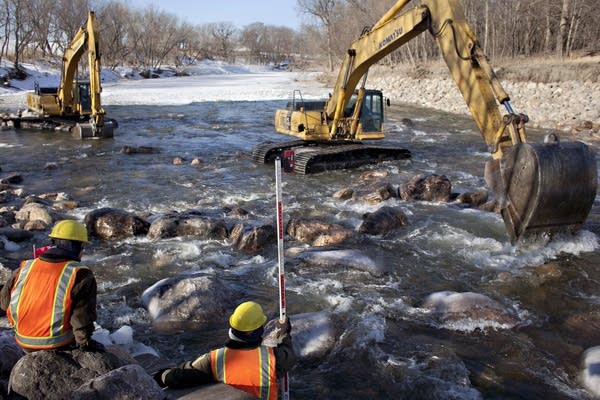Dam modifications restore wildlife habitat, improve safety
Go Deeper.
Create an account or log in to save stories.
Like this?
Thanks for liking this story! We have added it to a list of your favorite stories.

Construction crews in northwest Minnesota are finishing work this week on a unique river project — one that not only restores fish habitat, but could also save human lives.
The state Department of Natural Resources is modifying dams on the Red River to reconnect hundreds of miles of fish habitat for the first time in decades. Many of these dams were built to hold pools for city drinking water supplies during the extended drought of the 1930s.
The seventh dam on the Red River to be transformed into a rocky rapids in the past 15 years lies a few miles south of Fargo-Moorhead. That's where DNR River Ecologist Luther Aadland recently stood thigh deep in the frigid water and directed a large backhoe positioned in the middle of the river.
The backhoe operator carefully adds to the tons of rocks rocks just below the water so that the dam will stay in place, but a new, gentle rapids will allow fish to travel upstream to spawn.
Turn Up Your Support
MPR News helps you turn down the noise and build shared understanding. Turn up your support for this public resource and keep trusted journalism accessible to all.
There's one more Red River dam near the Canadian border to be modified.
Aadland hopes that will happen within a few years.
The project reconnects about 400 miles of the Red River which have been divided by dams since the 1930s, Aadland said. "It's been a huge success and other states are taking note," he said. "It's probably unprecedented in the world where we've had this many miles of river reconnected and restored."
BRINGING FISH SPECIES BACK
The DNR has evidence these projects work. Fish quickly take advantage of new territory when then they can move upstream past the dams.
Explaining what happened when dams were modified, Red River Fisheries Specialist Tom Groshens said, "We'd only got two channel catfish upstream of those in several surveys, and immediately after that we got 250. We've seen several examples of where there's been dramatic changes in fish population upstream when we modified these dams."
About 70 species of fish live in the Red River, the DNR said, including one species that is making a comeback because of the dam modification projects. The Red River was once home to sturgeon weighing hundreds of pounds. The DNR and the White Earth Nation are restocking sturgeon because they are now able to migrate upstream to spawn.

Turning dams into rocky rapids is credited to Aadland. He tested the idea on the Otter Tail River in 1994.
Today, the method has been used on dozens of Minnesota dams and it is being adopted in several states.
Minnesota has more than 1,250 dams. Hundreds should be modified or removed. The DNR has about 100 dams on a priority list, but limited funding means only a handful of projects are completed each year.
The DNR estimates $114 million is needed over the next 20 years to address dam safety issues. The agency spends about $1 million each year on dam projects. The DNR reports that it has removed 20 dams and modified 27.
This dam modification on the Red River will cost $800,000, shared between federal, state and local governments.
But the environmental benefits will last for generations, Aadland said.
MAKING THE RIVER SAFER

And there's also another benefit, Aadland said: saving human lives.
Dams create a powerful rolling current that is nearly impossible to escape. Even ducks and pelicans are sucked under. It's the reason the dams are sometimes called drowning machines.
A prime example is the Midtown dam, located in the heart of Fargo-Moorhead.
"In fact, that dam had a drowning every two years from the time it was built until we converted it to a rapids," Aadland said. "At least 19 and as many as 25 drowned at that spot."
The Midtown dam was modified in 1998 and since then no one has drowned there.
The modifications have also changed how people use the Red River. Now, it's not unusual to see kayakers playing in the rapids.
Increasingly, people are using the river for fishing, canoeing and kayaking, said Bob Backman, who heads the non-profit Fargo-Moorhead Riverkeepers organization.
Backman says that has intangible benefits for the long-term health of the river.
"When the river was known as a place where you could go to drown, perhaps you weren't as concerned about the cleanliness of the water," Backman said.
"As a result we have an increased interest in rain barrels and rain gardens and green roofs," Backman said. "All types of things people are trying to do to prevent polluted water from running into the river."
It's an example of a simple idea with surprisingly far-reaching effects, he said.



